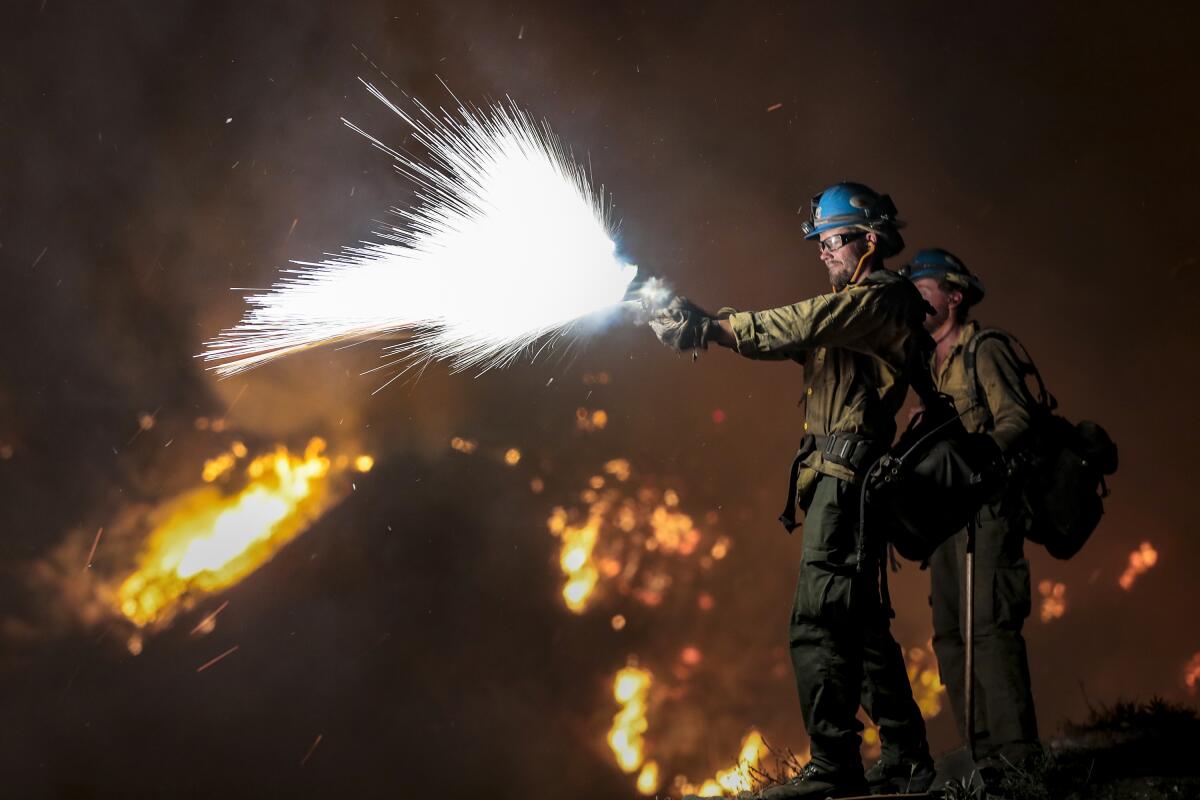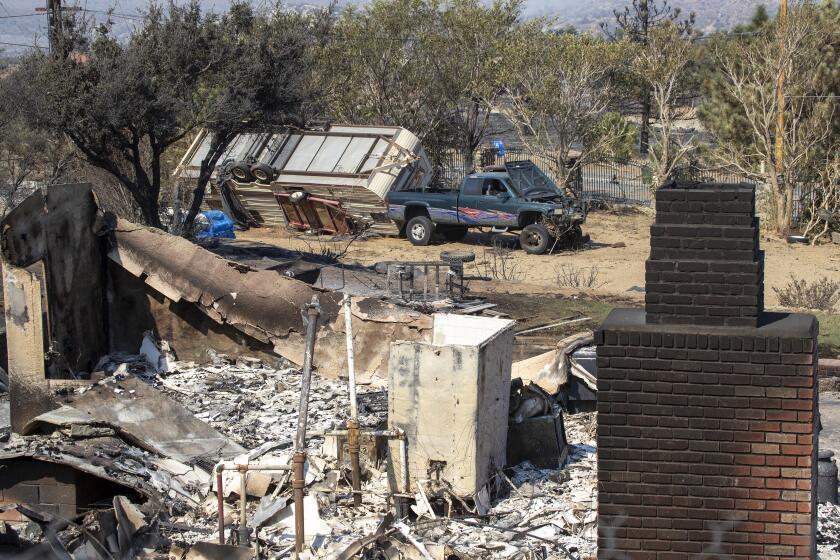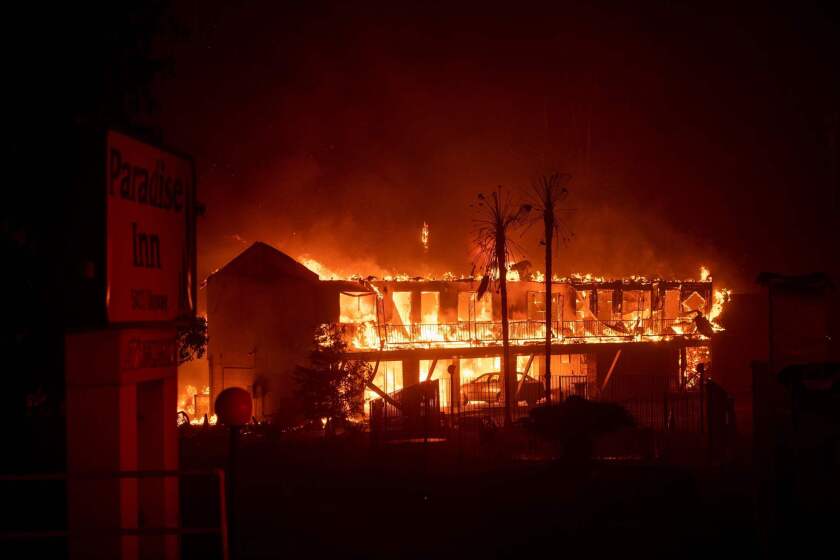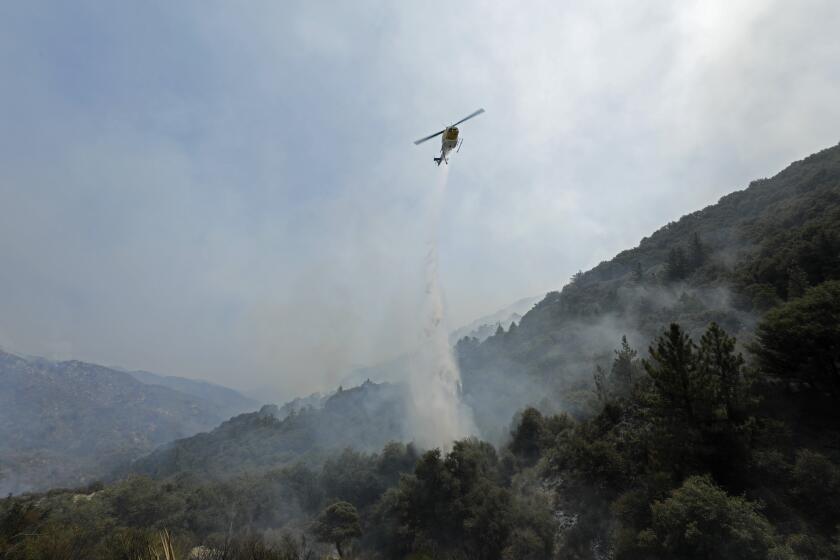‘If you think it’s bad now, just wait’: California faces new fire threats, further straining resources

- Share via
OROVILLE, Calif. — California has already endured its worst fire year in recorded history, but with more heat and wind in the forecast, officials say conditions could get even worse as the state enters the peak of its traditional burning season.
Another heat wave is bearing down on California — presenting an unwelcome double threat in a state where firefighting resources are already stretched thin. Conditions like those expected this weekend can make it harder to contain still-burning fires and easier for new ones to spark.
The heat will arrive at what’s already a dangerous time from a fire perspective. In recent years, some of California’s worst blazes have ignited in October, November and even December, when hot Santa Ana, sundowner and diablo winds bear down, fanning the flames.
“There are another two months of drama ahead,” climatologist Bill Patzert said. “If you think the season is bad now, just wait.”
With a warming climate and increased human development, more fires are in our future, firefighting veteran says.
Firefighters are scrambling to increase containment of the more than 20 major fires now burning across the state — from the Bobcat fire in the Angeles National Forest to the North Complex fire northeast of Oroville — before the worst of the heat and winds begin.
They warn that intense winds, combined with hot and dry conditions, can lead to explosive fire growth — even in blazes that have been burning for weeks. The North Complex fire, for example, had been slowing before, propelled by winds, it morphed into a monster that has now burned nearly 2,000 structures and killed 15 people.
Five of the six largest blazes ever recorded in California have ignited since August. Although crews have made substantial strides in getting those under control, some — including the massive August Complex fire — remain mostly uncontained.
Adverse changes in the weather, such as increasing temperatures or winds, present new challenges in fighting those already immense and complicated conflagrations.
On Thursday, firefighters working the North Complex fire in Butte County were trying to battle flare-ups pushing into the Forbestown area, said Shane Lauderdale, a Cal Fire branch director.
“[The] focus of the teams in there today will be going in deep for mop-up activities for the next three days,” he said, “in front of our change in weather.”
At the August Complex — by far the largest in California history at more than 862,000 acres — officials warned that gusty conditions expected this week could lead to spot fires.
“Any embers up on the ridges will be able to be lofted and put forward so ... there’s a potential for spot fires ahead of the fire, maybe up to a mile with those types of winds,” Karen Scholl, operations section chief for the Alaska Interagency Incident Management Team, said during a briefing Wednesday morning. “It all depends on where the embers start from.”
In Trinity County, one of California’s most rugged and forested counties, firefighters are bracing for tough days ahead. With fire crews stretched thin, volunteer departments are making last stands across the area, asking for help and equipment to save homes that belong to family and friends.
Kody Ables, a volunteer and dozer driver with the Southern Trinity Volunteer Fire Department in Mad River, has been building containment lines for 15 days. Tuesday night saw the fire reach that trench — then fly over in places, with embers starting small burns.
On Wednesday, after a night shift, he woke to a call that the fire was within a few hundred yards of a friend’s house.
“It’s starting to scare me,” he said.
Ables says his unit runs on a shoestring budget, funded by cookouts and an annual rodeo that was canceled this year amid coronavirus concerns. Now, the crew needs new tires for their truck, boots that can handle structure fires and new fire suits.
“Ours, they are pretty outdated,” he said. “We are doing the best we can.”
The forecast is not encouraging. This upcoming heat event is on track to be “major, prolonged and potentially record-breaking,” according to UCLA climate scientist Daniel Swain.
A large area of high pressure covering almost the entire West Coast is expected to build over the weekend, eventually boosting the mercury to record-threatening peaks in some parts of California early next week, according to David Sweet, a meteorologist with the National Weather Service in Oxnard.
Although the heat won’t spike to levels seen in mid-August and during Labor Day weekend, temperatures could climb 10 to 20 degrees above normal.
“We’ll have to be concerned about the rapid spread of fires,” Sweet said.
It appears Central California through southern Oregon will see the “most anomalously hot” temperatures, Swain wrote on Twitter, as well as “very dry air and modest offshore flow.”
“This will create very elevated fire weather conditions once again,” he said, “which will aggravate existing fires and be conducive to new starts.”
Swain said the heat wave would likely last through the first week of October — an ominous forecast given how bone-dry California remains.
Even beyond the upcoming heat wave, fire experts say the conditions in California are primed for destructive fires that will take much more than Mother Nature to tame.
“The broad confluence of factors that you got there in California — the Mediterranean climate, the [dead trees] in the Sierra and then over 2 million properties at risk — shouldn’t be a surprise,” said Tom Harbour, retired fire chief of the U.S. Forest Service. “It’s trite to say [but] this isn’t the worst of it.”
A fire weather watch will be in effect Saturday through Monday for a swath of Northern California, thanks to hot temperatures combined with low humidity and gusty winds, said Daniel Berlant, a spokesman for the California Department of Forestry and Fire Protection.
The watch covers a somewhat horseshoe-shaped area, stretching from just above Redding southeast into the Sierra foothills, as well as down into and around the San Francisco Bay Area.
“The atmosphere is going to be dry and warm,” meteorologist Drew Peterson said, “and all these ingredients together lead to critical fire weather.”
Pacific Gas & Electric Co. spokesman Jeff Smith said the utility’s meteorologists were closely monitoring the conditions but that no decision had been made about possible power shutoffs.
Although Southern California was not included in the watch area, “very hot and dry conditions will bring an elevated threat for large fire Sunday through early next week,” according to a forecast from the Southern California Geographic Area Coordination Center.
“Even though winds will be fairly light, rapid rates of spread will be possible in the afternoons where fuels and topography are favorably aligned,” that forecast states. “Fires will be able to burn actively at night since humidity recovery will be very poor.”
Gusty offshore winds will lead to critical fire danger in parts of Northern California over the weekend. PG&E is watching to see if power shutdowns will be needed.
Those conditions seem set to further strain crews working to get a handle on some of the largest blazes the state has ever seen.
One of those is the Creek fire in the Sierra foothills northeast of Fresno. At more than 290,000 acres, it’s the sixth-largest fire recorded in state history — and the biggest standalone blaze that’s not part of a complex of fires.
“Things are going to be kind of slow and steady before we start building the heat Saturday and especially late in the weekend and into the following week,” said Mark Pellerito, an incident meteorologist for the fire.
Although the fire was 34% contained as of Thursday morning, that figure — which represents how much of a fire’s edge firefighters think they can stop from expanding — is only part of the equation. Unburned fuels in the fire footprint can still potentially flare up, particularly during adverse weather.
Don Watt, a fire behavior analyst for Cal Fire Incident Management Team 1, described these as “islands inside the fire.”
“As we continue to get warm and dry, those will continue to burn, and we’ll have a lot of smoldering material,” he said during a briefing.
“There’s a very high concentration of dead and downed fuels with the tree mortality,” he said this week, and “those will take weeks to burn out in some areas.”
The forecast also is a concern for crews battling the Bobcat fire, which has blazed a destructive trail through the Angeles National Forest from the foothills above Monrovia to the Antelope Valley.
Crews, however, have made significant progress in their fight against the blaze, which ignited Sept. 6 and has burned more than 113,000 acres. As of Thursday morning, containment was at 50%, nearly tripling in a little over 36 hours.
The Bobcat fire has burned 113,000 acres and destroyed nearly 50 structures, but officials say it will be contained by Sept. 30, a month earlier than projected.
Containment of the sprawling August Complex — burning in and around the Mendocino, Shasta-Trinity and Six Rivers national forests — now sits at 39%, but its sheer size poses a massive challenge for fire crews.
As of Sunday, officials said the fire’s perimeter was more than 568 miles. By comparison, San Diego is about 500 miles from Sacramento by car.
The enormity of that fire is one of a number of alarming data points wrought by the 2020 fire season. So far this year, there have been over 8,000 wildfires that have burned more than 3.6 million collective acres statewide, the most in any year on record, according to Cal Fire. Over 18,200 firefighters are currently battling blazes across the state.
There have been 26 confirmed deaths in the historic firestorm, including three firefighters, and more than 6,600 structures have been destroyed.
Times staff writers Pinho and Chabria contributed to this report from Sacramento, Dolan from Orinda, Calif., and Money, Hayley Smith, Joseph Serna and Paul Duginski from Los Angeles.
More to Read
Sign up for Essential California
The most important California stories and recommendations in your inbox every morning.
You may occasionally receive promotional content from the Los Angeles Times.
















